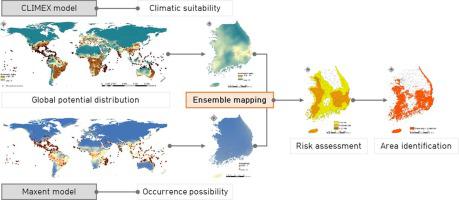Journal of Asia-Pacific Entomology ( IF 1.1 ) Pub Date : 2021-01-19 , DOI: 10.1016/j.aspen.2021.01.007 Wang-Hee Lee , Jae-Min Jung , Heung-Sik Lee , Jong-Ho Lee , Sunghoon Jung

|
The longhorn crazy ant (Paratrechina longicornis) is a globally distributed ant species with a high invasion risk, suggesting the need to use species distribution modeling to evaluate its potential distribution. Therefore, this study aimed to predict the potential distribution of longhorn crazy ants in response to climate change by using CLIMEX and Maxent and identifying the climatic factors that influence their habitat. Then, the model outcomes were used to construct an ensemble map to evaluate invasion risk in South Korea. The results indicated that temperature-related variables mainly affect the distribution of the longhorn crazy ant, and the two models showed consensus regions in South America, Africa, Australia, and Southeast Asia. Due to climate change, it was expected that the northern limit would somewhat rise. In South Korea, high-risk areas were predicted to be located along the coasts, but they would expand as a consequence of climate change. Since the invasion of longhorn crazy ants has occurred via commercial trades, a relatively high risk in coastal areas demands a high level of attention. We expect that this study will provide initial insight into selecting areas for longhorn crazy ant quarantine with ensemble species distribution modeling.
中文翻译:

利用空间分布模型评估韩国长角疯狂蚂蚁(Paratrechina longicornis)的入侵风险。
长角牛疯狂的蚂蚁(Paratrechina longicornis)是具有高入侵风险的全球分布的蚂蚁物种,这表明需要使用物种分布模型来评估其潜在分布。因此,本研究旨在通过使用CLIMEX和Maxent并确定影响其栖息地的气候因素来预测响应气候变化的长角牛疯狂蚂蚁的潜在分布。然后,将模型结果用于构建整体地图,以评估韩国的入侵风险。结果表明,温度相关变量主要影响长角疯蚂蚁的分布,两个模型显示了南美,非洲,澳大利亚和东南亚的共识区域。由于气候变化,预计北部界限将有所上升。在韩国 预计高风险地区将位于沿海地区,但由于气候变化,它们将扩大。由于长角牛疯狂蚂蚁的入侵是通过商业交易发生的,因此沿海地区相对较高的风险需要引起高度重视。我们希望该研究将通过集合物种分布模型为选择长角疯蚂蚁检疫的区域提供初步见识。











































 京公网安备 11010802027423号
京公网安备 11010802027423号